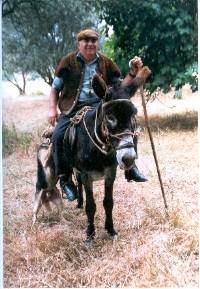Alentejo: "Além do Tejo"
translated: "beyond the river Tagus ",
 ... in Southern Portugalnorth of the Algarve. It stretches over an area of over 26 000 square kilometres between the Tejo and Guadjanawhich is a third of the total country area. The population density with its 20 inhabitants per square kilometre is the lowest in Portugal and one of the lowest in the whole of Europe. The Alentejo offers a continental maritime climate and over 3000 hours of sun per year.
... in Southern Portugalnorth of the Algarve. It stretches over an area of over 26 000 square kilometres between the Tejo and Guadjanawhich is a third of the total country area. The population density with its 20 inhabitants per square kilometre is the lowest in Portugal and one of the lowest in the whole of Europe. The Alentejo offers a continental maritime climate and over 3000 hours of sun per year.
The dimensions of the landscape are breathtaking. Besides the wide planesthere are also the white villagescastles and towns. This region is still rich in their ancient traditionsthe old customs are still in use nowadays. Summer is the time of massesfestivals and pilgrimages. In the eastern and southern parts one can encounter a wonderful hilly landscape with oakscork oaks and olive treesand also blooming meadows. The great variety in landscape makes this area so delightful.
Whoever wants to spend their "most beautiful weeks of the year" in the sunny south without the mass-tourism-supporters will find that the southern Portuguese province Alentejo will be a good hint for some more time. The Atlantic climate is always bearableeven during midsummerbecause of a constant fresh breeze. Especially during spring time a unique collection of flowers awaits you.
The Alentejo is still well-known for its beaches in the "Parque Natural do Sudoeste Alentejano e Costa Vicentina". The nature preserve at Costa Vicentina stretches from Sines in the north via Sagres due east to the Algarvian coast. It is considered inimitable in Europe. Rocks and cliffs alternate with dunes and little forests. The choice between wide sand beaches and little bays might well be difficult.
In addition to thisthe diversified gastronomy belongs to the variety of this region. The sea and the land deliver plenty of outstanding foods for the preparation of simple and more complex meals. Starting with fishwhich is always fresh here,complemented so perfectly by the region´s full-bodied wines. In the comfortable restaurants and cafes one can experience the Portuguese way.
The most untouched European coast
 ... and the extensive possibilities of exploring the inland nature make it worth seeing. Howeverthe most beautiful thing about the Alentejo is certainly its population.
... and the extensive possibilities of exploring the inland nature make it worth seeing. Howeverthe most beautiful thing about the Alentejo is certainly its population.
The people from the other parts of Portugal frequently make jokes about the slow pace in the Alentejo but everyone loves the cuisinethe music and the handicraft of this province. In the same wayeveryone is fascinated by the lifestyle of the Alentejanostaking every day as it goes by. Old farmers' traditions have been held upright in the region. Summer is the time of fairsfestivals and pilgrimages.
In June the whole district celebrates the Santos Populares (The public saints). Especially worth seeing is the celebration of the Mastros de São Teotóniowhere women dressed in liveries carry water jugs on their heads or around their hips. In July the FACECO exhibition (Feira das Actividades Culturais e Económicas do Concelho de Odemira - The fair of cultural and economic activities in the Odemira district) is celebrated in S. Teotónio. The traditional Alentejan chants and the unique sound of the Alentejan guitars give the festival its own atmosphere.
The Alentejo is extremely rich in archaeological remains that bear testimony to different stages in the development of human life over thousands of years.
One can see them everywhere in the Alentejo: freshly peeled cork oaks. Their bark can only be taken off once in 9 years. It is then processed to pruduce corks. 50% of the world-wide cork production are achieved in the Alentejo. To straighten the barkseveral pieces will be stacked and are pinned down with stones. The cork oaks stretch their branches widely. In their shades cowspigs and goats unite. Storks build their nests on top of the electricity pylons at the edge of olive groves and wheat fields. Where mixed forests and olive trees stood some time agonowadays eucalyptus growsthe "green petroleum".
| Back |  |
 |
 |
Facts |
Information:
This page shows basic information. There is no guarantee for the correctness and completeness of the given facts. The page is regularly updated.






